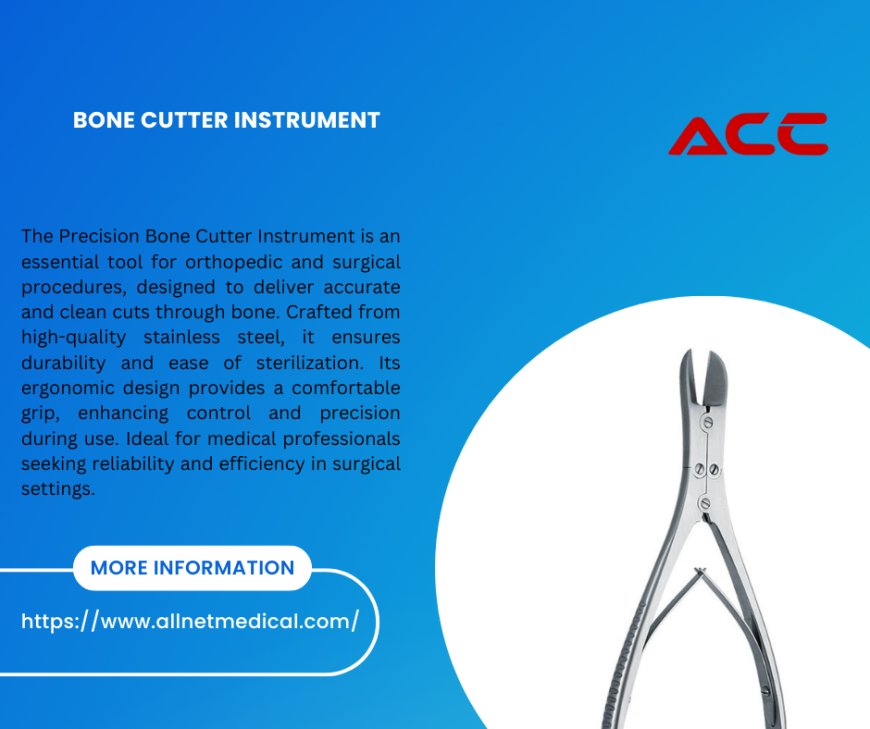The Future of Bone Cutter Instruments in Surgery
The bone cutter instrument has long been a critical tool in various medical fields, ranging from orthopedic and dental surgery to maxillofacial and neurosurgery.

The bone cutter instrument has long been a critical tool in various medical fields, ranging from orthopedic and dental surgery to maxillofacial and neurosurgery. With advancements in technology and the ongoing evolution of surgical techniques, the future of bone cutters and bone cutting forceps promises to be transformative. Innovations are making these instruments more precise, efficient, and safe for both surgeons and patients. This article will explore the future of bone cutter instruments, highlighting emerging technologies and their potential impact on surgery.
Key Trends Shaping the Future of Bone Cutter Instruments
1. Robotic-Assisted Surgery
One of the most significant advancements shaping the future of bone cutting instruments is the integration of robotics. Robotic-assisted surgery allows for more precise movements and cuts, enhancing the accuracy of procedures that require bone manipulation.
-
Precision Cutting: Robotic systems can be programmed to make highly accurate bone cuts based on preoperative imaging. This minimizes the risk of human error and improves patient outcomes, particularly in complex surgeries like joint replacements or spinal fusions.
-
Minimally Invasive Procedures: Robotic systems, combined with advanced bone cutting forceps, can allow surgeons to perform less invasive procedures. Smaller incisions reduce the risk of infection, minimize blood loss, and speed up patient recovery.
-
Consistency and Control: Robots offer greater control over cutting angles and depths, making them ideal for surgeries requiring high precision. The consistent performance of robotic tools will help eliminate variability in procedures, leading to better long-term results.
2. Laser-Assisted Bone Cutting
Laser technology is making its way into the realm of bone surgery, and its application is likely to shape the future of bone cutter instruments. Lasers offer unmatched precision and the ability to make cleaner cuts with minimal damage to surrounding tissue.
-
Precision: Lasers can cut through bone with exceptional accuracy, allowing for more controlled bone removal. This is particularly useful in delicate surgeries like cranial procedures, where minimal disruption to surrounding tissues is essential.
-
Reduced Trauma: Unlike traditional mechanical bone cutting forceps, lasers cause less trauma to the bone, reducing bleeding and post-operative pain. This leads to faster healing times and fewer complications during recovery.
-
Improved Outcomes: By using lasers, surgeons can perform procedures with increased precision, resulting in better surgical outcomes. The use of laser-guided systems for bone cutting will likely become more prevalent in complex procedures such as facial reconstruction and dental implants.
3. 3D Printing for Customized Bone Cutters
3D printing technology is revolutionizing the design and manufacturing of surgical instruments, including bone cutter instruments. Customized tools, specifically tailored to a patient’s anatomy, are set to improve surgical outcomes significantly.
-
Custom-Fit Instruments: Surgeons will soon be able to use 3D printing to create bone cutting forceps and other instruments that are designed specifically for an individual patient's bone structure. This level of personalization ensures a better fit during surgery, leading to more accurate procedures.
-
Preoperative Planning: 3D printing allows for the creation of surgical guides that match a patient's exact anatomy. Surgeons can print models of bones or joints ahead of time to plan their cuts more effectively. This is particularly beneficial in complex surgeries like reconstructive facial surgery or joint replacements.
-
Cost-Effective Solutions: As 3D printing becomes more affordable, it will enable hospitals and clinics to produce custom instruments on demand, reducing the need for costly, one-size-fits-all tools. This will make advanced surgeries more accessible, even in smaller medical facilities.
4. Advanced Materials for Bone Cutters
The future of bone cutter instruments will also be influenced by the development of new, advanced materials that improve the durability, sharpness, and biocompatibility of these tools.
-
Superalloys and Ceramics: Modern bone cutters may be crafted from advanced materials like superalloys or ceramics, which offer greater strength and sharper cutting edges than traditional stainless steel instruments. These materials maintain their sharpness for longer, providing surgeons with better control and reducing the frequency of instrument replacement.
-
Biocompatibility: As surgical techniques evolve, the materials used in bone cutting forceps will need to become more biocompatible. This will ensure that instruments do not cause adverse reactions in the body during surgery, leading to safer, more effective procedures.
5. AI and Machine Learning in Surgery
Artificial intelligence (AI) and machine learning (ML) are expected to have a significant impact on surgical instruments, including bone cutters. AI-driven systems will assist surgeons by analyzing real-time data during surgery to optimize cutting techniques and decision-making.
-
Predictive Analytics: AI can help predict the best bone cutting angles and force based on patient-specific data, allowing surgeons to make more informed decisions during surgery. This can lead to better alignment in orthopedic procedures and more precise bone removal in cranial or facial surgeries.
-
Real-Time Feedback: AI-enabled bone cutting instruments can provide surgeons with real-time feedback, such as resistance levels or bone density. This feedback helps surgeons adjust their cutting techniques on the fly, reducing the risk of complications.
-
Augmented Reality (AR) Integration: In combination with AI, augmented reality (AR) systems can project virtual images of bones and cutting paths onto the surgical field. Surgeons using bone cutting forceps can follow precise visual guides, making their procedures more accurate and efficient.
6. Motorized and Battery-Powered Bone Cutters
While manual bone cutting forceps have been widely used for decades, the future is seeing a shift towards motorized and battery-powered versions that offer more speed and efficiency.
-
Power-Assisted Cutting: Motorized bone cutters allow for faster bone removal, reducing surgeon fatigue and the time patients spend in the operating room. This technology is especially beneficial in surgeries requiring large bone cuts, such as hip replacements or spinal decompression.
-
Improved Control: Advanced motorized bone cutters can be equipped with adjustable speed settings and cutting angles, giving surgeons more control during procedures. These instruments can also offer smoother cuts with less effort, enhancing both the surgeon’s performance and patient outcomes.
Conclusion
The future of the bone cutter instrument is set to be defined by advancements in technology, materials, and surgical techniques. Bone cutters and bone cutting forceps will continue to evolve, with innovations such as robotic-assisted surgery, laser technology, 3D printing, and AI-driven systems leading the way. These developments promise to enhance precision, reduce surgical complications, and improve patient recovery times. As the medical field advances, bone cutter instruments will remain at the forefront of surgical innovation, ensuring better outcomes for patients across various medical disciplines
What's Your Reaction?











![Tranquil Blend CBD Gummies [Price UPDATED 2024] - Cost Solves](https://news.bangboxonline.com/uploads/images/202412/image_430x256_676d404cc1dc0.jpg)











